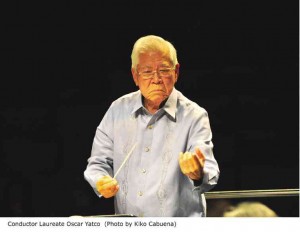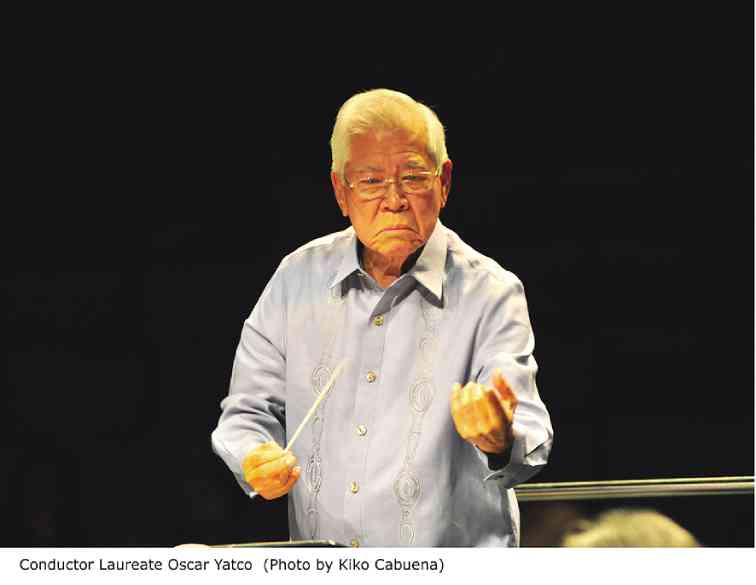
The Philippine Philharmonic Orchestra (PPO) wowed Manila’s music lovers at two recent special concerts: “Elegantly Brahms” and “Nostalgic Concerts.”
The first was held at Philamlife Theater, the second at the CCP Little Theater.
“Elegantly Brahms” marked the powerful tandem of Olivier Ochanine, PPO’s principal conductor and music director and Sofya Gulyak, first woman Leeds International Piano Competition winner, in Brahms’ Piano Concerto No. 2 in B-Flat Major, Op. 83.
The tandem marked their second collaborative engagement, the first being the last PPO concert in yet another work by Brahms, the Piano Concerto No.1 in D Minor, Op. 15. Completing the program was Brahms’ Symphony No. 4 in E Minor, Op. 98.
Two bicentenaries
Earlier, conductor laureate Oscar C. Yatco led the PPO in “Nostalgic Concert,” at the CCP’s Little Theater in commemoration of the birth bicentenaries of Verdi and Wagner. The program consisted of Verdi’s “I Vespri Siciliani” Overture; Wagner’s “Tannhauser” Overture and Tchaikovsky’s Symphony No.6 Op. 74, in B Minor, First and Third Movements.
The concerts afforded the audience awesome moments of listening as two conductors wielded brilliant symphonic sounds.
The one-hour program was cut in consideration of Yatco’s health as he suffered cardiac discomfort during his last conducting stint. He certainly was at home with the works he conducted.
Unmistakably the sound carried that Yatco magic, that brilliant symphonic sonority he capably drew from the orchestra during his long, intimate and fruitful career as principal conductor of the PPO.
Well-combed was the rendition of Verdi’s overture. The Wagner overture was sensuously rich in tonal colors.
One wished Tchaikovsky’s “Pathetique” were rendered in full. The rendition of the first movement chilled one’s spine, so to speak. Played sans sentimentalism, its melancholic disposition was utterly moving.
The third movement effectively provided a stark contrast as the mood shifted at once to the lighter side. An encored Brahms “Hungarian Dance” capped the program.
Monumental spark
The same symphonic excellence was brought forth in the more recent concert with the young, dynamic conductor, Ochanine, who conducted two big works of Brahms. Olivier effectively wielded the baton to bring the monumental spark of the works.
Rapport between him and pianist Gulyak was tightly secured. The piano became an essential part of the symphonic fabric. Gulyak towered with her rich, robust sound, grounded on a fantastic technical brilliance.
She easily fused technical prowess with the fiery temperament called for by the work. Such a feat was not shown in a solo-tutti dialectics between the piano and the orchestra that usually characterizes piano concertos. This time the piano had become an integral part of the symphonic work.
In the opening of the first movement, for instance, she reflected the horn theme with cunning disposition expressed with poetic charm. Her sonorous and dramatic cadenza soon gave way for the orchestra to etch the exposition.
The joyous trio of the second movement somehow prepared the listener to a most fulfilling and haunting slow movement in the third. Although the solo cello could have sung more warmly, in the main the entire section was rendered movingly. The ebullience of the last movement fittingly capped the concerto.
Intelligent fusion
Indeed, the concerto was a big canvas whose design Ochanine and Gulyak had filled with arresting musical designs, so to speak. They integrated their individual sensibilities dynamically to arrive at a truly intelligent fusion. Intimacy ruled their ensemble that ensured an awesome rendition.
Ochanine wielded the baton with the same fervor in Symphony No. 4. Rarely glancing at the score, he rendered the work with a broad, mighty sweep. Evidently he wielded his baton with gusto and moved the musicians to play with abandon.
From the serene first movement, his baton wielded a ravishing elegiac mood in the second movement and allowed the cellos to sing elegantly.
Symphonic might was sounded in the third movement, and a ravishing set of variations in the fourth movement capped the performance.
Whatever heaviness one felt in the first three movements was quickly dispelled by the à la Baroque charm of the fourth movement that, indeed, ensured glorious listening.













































